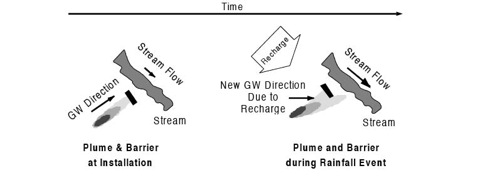
Lab Studies and Site Characterization for Permeable Reactive Barrier Walls
Hydrologic Characterization
As with any ground water remediation technique, adequate hydrologic characterization must be done to understand the ground water flow patterns and the distribution of the contaminant plume. This is especially important for the installation of a permeable reactive subsurface barrier since the entire plume must be directed through the reactive zone of the barrier. To attain a "passive" remediation system, the barrier must be placed in a location that allows the plume to move through the reactive zone using the natural ground water gradient. The gradient must do all the work.
Information that must be obtained includes the piezometric surfaces and gradient, the hydraulic conductivity, permeability, porosity, and the other hydrologic parameters typical of a careful and complete subsurface characterization. It is also important to understand seasonal changes in flow direction and flux, since the reactive wall must be designed to accommodate these changes. An awareness of the effects of large pumping systems at the site, such as water supply wells or pump and treat remediation technologies, must also be known. This type of effect can be intermittent and have unforseen influences on the flow conditions. The figure below illustrates how changes in ground water flow can reduce the effectiveness of a reactive barrier system due to incomplete plume capture. In the left depiction, the wall has been installed and the plume is moving through it exactly as designed. The right depiction shows how an unexpected change in ground water flow direction, in this case due to recharge from an unexpected source, could result in plume diversion around the barrier.








